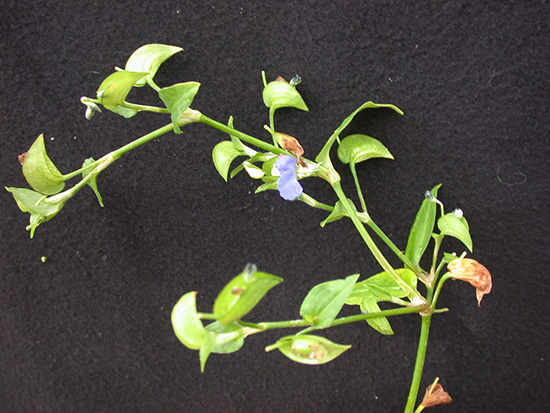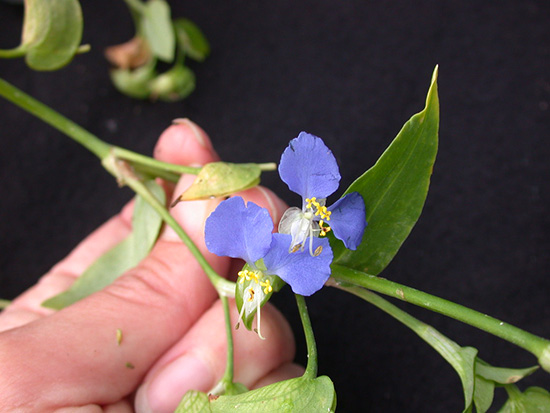Issue 10, June 28, 2013
Asiatic Dayflower The Little Beauty that Caused So Much Confliction
The jury is out on Asiatic dayflower. Half of them are out enjoying how their gardens have been graced with this plant's pretty blue flowers. The other half is (and likely has been for quite some time) waging war on this invasive weed. How can we be so divided when it comes to this escaped ornamental?

Who could resist the blue flowers?
I stumbled across an interesting discussion online about Asiatic dayflower (Commelina communis), also known as common dayflower and blue dayflower. Here are some direct quotes from that discussion. Naturally, it could leave one a little conflicted:
- "This plant is gorgeous in early to mid-Summer!"
- "Invasive as they get--one of my biggest pests!"
- "They are the most pleasing shade of blue in my gardens!"
- "I finally have a name for this little beastie. I called it Hitler-weed because it invaded everything around it. I'll be pulling this until the day I die. Once established just try to get rid of it. I dare you.
I too have battled Asiatic dayflower for admittedly many years now. It always returns to the same spot. According to weed scientists at Iowa State University and University of Nebraska Lincoln1, seed dormancy is an important adaptive characteristic of this genus. They and others who have researched this weed report that more than 80% of the seeds can germinate even after four and a half years in the soil seed bank. That's fairly high. Additionally, seeds can germinate throughout the growing season. This creates steady work for weeders. I can understand why many have decided to simply live with this weed.
Recently I found it in a new area -- in the windbreak bordering the south end of my property -- and the thought actually crossed my mind, "Do I really want to fight it here? The blue flowers are stunning though a little small." The realist in me says, "no, I'm tired of fighting" but the stubborn perfectionist in me says "hell yes". I'm conflicted.
This windbreak borders a field. I trust my farmer neighbor would rather I control it before it spreads to his field. Asiatic dayflower is becoming a troublesome weed for farmers because it is difficult to manage and can easily survive applications of glyphosate (Roundup and others). Just to clarify, its survival is NOT a result of the increased use of glyphosate. However, we are seeing more of this plant in agricultural production fields because of the increased use of glyphosate. Other competitive weeds are killed while this one is left to survive and take over. And it will.

Asiatic dayflower has an ascending habit.
Research by weed scientists in Connecticut2 found that flumioxazin (BroadStar, SureGuard, Chateau and others) provided excellent season-long control of Asiatic dayflower. There are additional reports that triclopyr (Turflon and others) is effective against this weed. Remember to carefully read and follow all label directions.
Hand pulling can be effective if the soil is moist. Often however, stems will simply break off. Stems are capable of rooting at the nodes. Be sure to discard pulled plants. Prevention of seed development is also highly recommended. It cannot tolerate mowing, so it is not commonly found in lawns. It prefers moist, rich soil and shade. Cultivation may be used.
Many are surprised to learn that this somewhat creeping or ascending plant is an annual monocot -- even though its leaves are up to 1.5 inch wide, much wider than that of most grasses. The seedlings look grassy with parallel veins. It is a member of the spiderwort family. The stems & leaves are thick and fleshy. Stems can reach 1 to 3 feet in length and the nodes are swollen or bumpy. Leaves have smooth margins and no petiole; they are 2-4 inches long. There is a sheath at the base of each leaf that clasps the stem. The flowers are pretty with 2 large petals above one smaller white petal. They are found July through September in small clusters in the leaf axils. Look quick, because they only last a day (its name should have tipped you off) and they aren't very big.
If you are feeling adventurous (and hungry), this plant is edible according to my Peterson Field Guide. This 2 minute video (http://www.youtube.com/watch?v=4D5MsCkl1FM ) shows the many uses that one person has found for it. I think the blue flowers make her dishes quite attractive.
Eating this weed can aid in revenge seeking. I'll share with you one last comment I read that gave me a chuckle. "I like the idea of dropping the little shoots in butter and watching them wilt...I really do not like this plant." (Michelle Wiesbrook)
1. Response of Asiatic Dayflower (Commelina communis) to Glyphosate and Alternatives in Soybean. Santiago M. Ulloa and Micheal D.K. Owen. Weed Science, Vol. 57, No. 1 (January-February 2009), pp. 74-80; http://www.jstor.org/stable/40586977
2. Effective Herbicides for Asiatic Dayflower Control in Conifer Beds. Mervosh, T.L. and J.F. Ahrens. Connecticut Agric. Exp. Stn., Windsor. Proceedings, Northeastern Weed Science Society, Vol. 57, p. 38 (2003); http://www.newss.org/proceedings/proceedings_2003_vol57.pdf
Author:
Michelle Wiesbrook